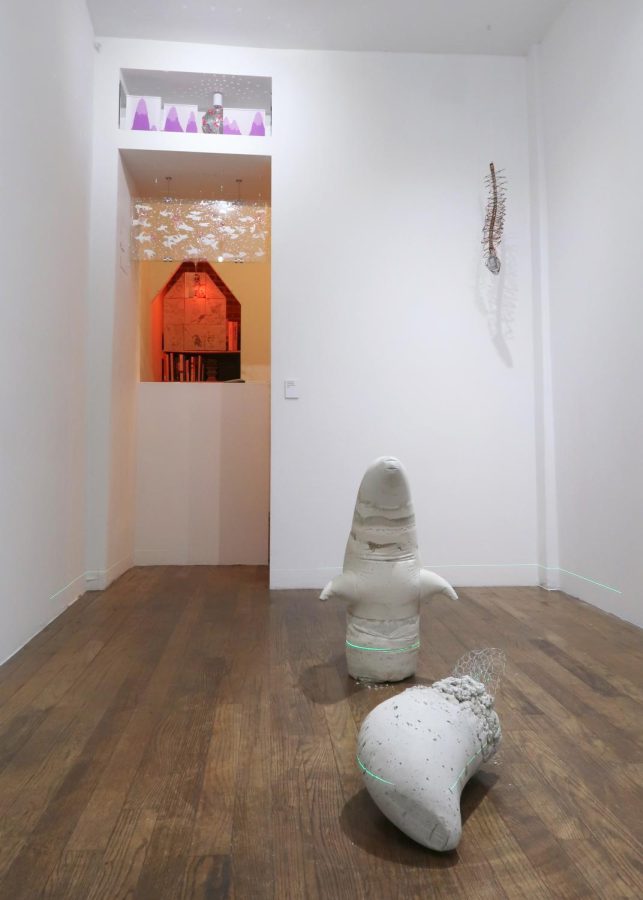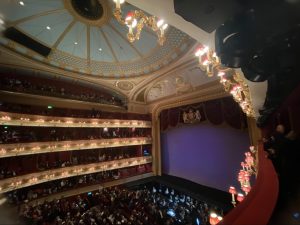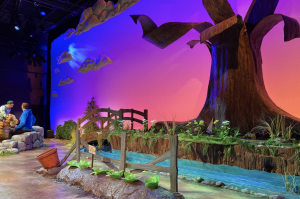‘Cocoon’: A Collective Reemergence
Student art exhibition offers a multiplicity of healing and metamorphosis
November 12, 2021
The ear on the ground listens to the hum of muted footsteps. Tights are stretched to their limits in an elaborate dance of strain and effort. A concrete dolphin is beached on a wooden floor, a far cry from oceanic origins.
In many ways, “Cocoon,” a group show featuring work by Master of Fine Arts students from the School of Visual Arts in New York City, is representative of our collective reemergence into the public sphere. The show ran from Oct. 28 – Nov. 3 at New Collectors, but its effects extend beyond the physical space of the gallery.
That is not to negate the integral role that the gallery space played in creating the claustrophobic environment necessary to fully embrace the poetics of the cocoon. The gallery is small and cozy. There is a back room that is smaller and cozier, and the washroom, even smaller, is perhaps the coziest.
Art fills each of these rooms and depicts an individual cocoon, unfolding within the shared space. Each addresses a state of emergence, searching and reaching toward the other. There is resistance, curiosity, light and the instability of change.
“Heavy Boots” — Maomì Melody Marissa
Maomì Melody Marissa’s “Heavy Boots,” an installation made from clay, plaster, tights, wood and balloons, demands your attention as you first step into the gallery. If you are not careful and aware of the space, you will tread on toes. This, of course, is not what you want. Dark tights extend from the boots and connect to the ceiling. The result is both dynamic and disconcerting. There is a sense of movement, or at least the possibility of it in a nearby future.
“Untitled (nowhere)” — Sangho Han
Immediately to the left is a disgruntled figure framed by blue, orange and yellow paint. Sangho Han utilized acrylic and pencil to paint directly on the gallery’s wall for his piece, “Untitled (nowhere).”
“Core signal” — Paulina Mendoza Valdez
“Core signal,” by Paulina Mendoza Valdez, is strung up directly across the entrance. The wire monster glows and flashes as it hangs from the ceiling, resembling a fish dragged up from uncertain depths. The shadows of the monster on the wall feel as though they might grow and contort if you look at them long enough. The work evokes a meditative state in the viewer, asking what may emerge from the multiplicity of existing and undercurrents of change.
This active engagement with the work implicates the viewer in the consequences of our interactions with nature.
“Throne Room” — Ellen Carpenter and “I Decided to Love the Sounds, Because I was Scared of the Letters” — Se Young YIM
There is hair and there are chairs. The light weight of the materials used in “Throne Room” by Ellen Carpenter allows the structure to hang with ease. The seats are tiny and makes one wonder who will fill them. Though the installations are separate cocoons, the fibrous material of Carpenter’s work calls attention to the fur of “I Decided to Love the Sounds, Because I was Scared of the Letters” by Se Young YIM located near the window. The fur is shaggy and seems like, if you came at the end of the week, it might have grown and stretched down to the floor. Sounds from the Busan Sea accompany the work.
“The Meadow of Sounds” — Kostas Lales
The idea of listening to nature and finding balance within one’s environment is foregrounded in “The Meadow of Sounds” by Kostas Lales. An IV bag hangs up the upturned ear surrounded by lentils which have yet to sprout.
“Phillipa” — M Sawyer Ballance
From the floor emerges a concrete dolphin, incomplete and in mourning. “Phillipa,” created by M Sawyer Ballance, offers a contemplation on post-industrial waste and environmental degradation. A green laser line mimics a metaphysical plane of ocean from which the viewer can also participate in an act of emergence. This active engagement with the work implicates the viewer in the consequences of our interactions with nature. Even in a man-made gallery in the Lower East Side, we cannot escape the effects of our actions on the natural environment.
A lone light bulb hangs directly above the chair, illuminating the remnants of the cocoon.
“A road with no end” — Weina Li
Birds trapped between panes of glass hang suspended from the doorway into the next room. “A road with no end,” created by Weina Li, invites viewers deeper into the physical space of the gallery and the intimate retreat of the cocoon. The viewer must negotiate how they will cross this threshold and squeeze into the inner chamber of the gallery.
“Lemon Meringue” — Dani Melen and “Pink Galaxy Portal” — James Jaxxa
Before the viewer enters, there is the red glow illuminating the drawings of Dani Melen’s “Lemon Meringue.” “Pink Galaxy Portal” by James Jaxxa is displayed above the birds in flight. The purple mountains and pulsing disco ball add to the surreal and otherworldly depiction of emergence and how one may navigate the cocoon. If birds fly below mountains and there is a disco ball in place of the sun, anything is possible.
“The Home” — Helia Chitsazan
Once inside the inner room, there is a domestic scene to the right. “The Home,” created by Helia Chitsazan, depicts inner quietude. This installation is a husk of a home. The interior is protected — covered by the curtains on the wall, the translucent fabric in the painting and the paper mache that clings to the chair as if a second skin has been shed. A lone light bulb hangs directly above the chair, illuminating the remnants of the cocoon. The installation makes the viewer wonder what remains when we change and how we find meaning in the markers of growth and abandonment.
Just when you think the show is over, the metamorphosis complete, you must forge ahead to discover the final installation.
“Makin’ the result” — Hwichan Ko (GEKSA)
Sometimes change is rebellious and requires long periods of reflection before the electric departure of the past. “We…I. CAN MAKE RESULT” is scrawled on the wall behind Hwichan Ko (GEKSA)’s depiction of a warrior marching ahead into an uncertain future. Green fades into orange mid-torso, and a neon orange glows from behind the figure. Black flames creep up the thighs and down toward the shins as the figure wields weapons of change in “Makin’ the result.”
“Connecting the dots” — Alamo Artworks
Just when you think the show is over, the metamorphosis complete, you must forge ahead to discover the final installation. “Connecting the dots” by Alamo Artworks hangs on the wall in the restroom. As a culture obsessed with our looks, the restroom is perhaps the most intimate and mundane cocoon we emerge from daily after performing rituals of self-care. It seems only fitting that an exhibition interested in growth and development should end in this unlikely space.
The work is a necklace of styrofoam and a meditation on the interconnectedness of seemingly disparate events. It is a game of dominos, a butterfly flapping its wings accompanied by a distant hurricane and the chaos that strings together change. It asks us how we are connected and how we will emerge together.
The Metamorphosis
The idea of the emerging artist is nothing new. It’s a term that can follow someone years into their practice, yet, in some ways there is a sense of vitality to the description. To emerge is to constantly challenge systems and established structures. As people, we must continue to show up, emerge and adapt to meet the changing conditions of our world. The need for a sense of solidarity and movement forward is evident in the collective emergence in public spaces, but it is equally important to cultivate change within.
Viewing art by young artists and students like ourselves encourages a more expansive view on how we internalize our own abilities for change, process that change and find balance along the way.
“Cocoon” expands the ways in which we can conceptualize and reach towards a shared moment of healing. It is slow. It is unfurling. But there is time and space to shed your cocoon and let it fall where it may.














